tow bar Peugeot Partner Tepee 2015 Owner's Manual
[x] Cancel search | Manufacturer: PEUGEOT, Model Year: 2015, Model line: Partner Tepee, Model: Peugeot Partner Tepee 2015Pages: 276, PDF Size: 12.76 MB
Page 7 of 276

5
Partner_2_VP_en_Chap01_vue-ensemble_ed02-2014
EXTERIOR
Remote control 18-19
Changing the battery ,
reinitialisation
19
Key
18
Starting
50
Hill start assist
51
Central locking /
unlocking
18, 27
Filler cap, fuel tank
147-148
Fuel cut-of
f, Diesel priming
148
AdBlue additive,
topping up
149-153, 154-156
Wiper blades
177
Door mirrors
103
Side repeaters
170
Front lamps, foglamps, direction indicators
52-54, 169-170
Headlamp beam height adjustment
54
Changing front bulbs
168-170
Headlamp wash
56, 144
Snow cover
166
Front doors
21
Sliding side
doors
22-23
Key
18
Opening the bonnet
140
Child lock
134
towing, lifting
178
T
owbar
135-136
Parking sesnsors
107-108
Rear roof flap
26e
mergency control
23
Spare wheel, jack,
changing a wheel,
tools
160-165temporary puncture repair kit
159
Inflation, pressures
188
Zenith roof
90-91
Roof bars
94, 95
Rear lamps, direction
indicators
52-53, 171-172
3rd brake lamp
172
Changing rear bulbs
168, 171-172
Doors, tailgate
23-25
Accessories
137-138
Number plate lamps
172 Dimensions
180-183
Brakes, pads
106, 143, 145e
mergency braking
109
ABS,
e
BFD
109
ASR, DSC
1
10
"
g
rip control"
1
11-112
tyres, pressures
188
Snow chains
167
T
yre under-inflation detection
3
9-40
1
OVeRVIeW
Location
Page 85 of 276
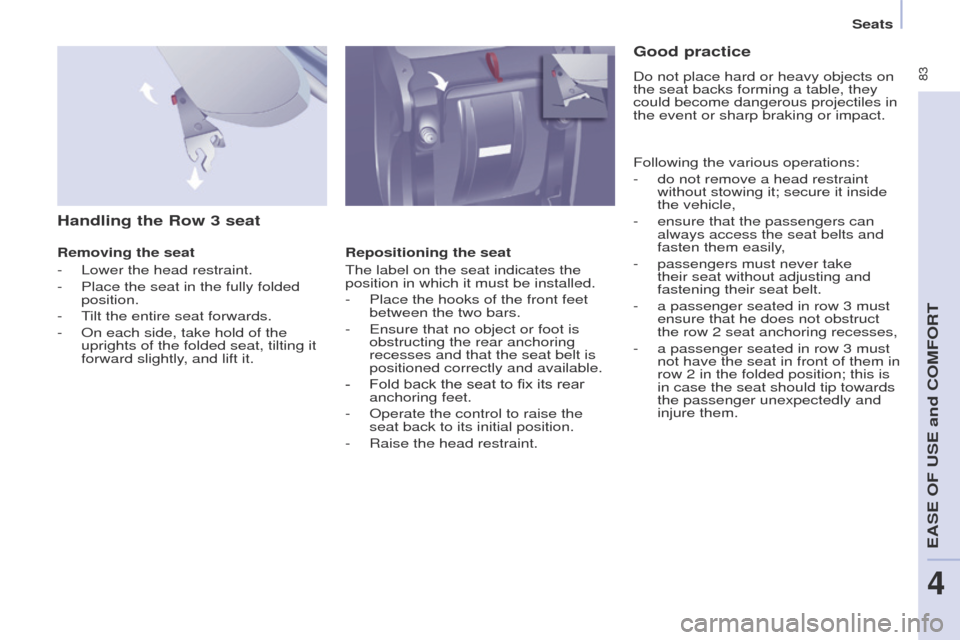
83
Partner_2_VP_en_Chap04_ergonomie_ed02-2014
Handling the Row 3 seat
Removing the seat
-
Lower the head restraint.
-
Place the seat in the fully folded
position.
-
t
ilt the entire seat forwards.
-
On each side, take hold of the
uprights of the folded seat, tilting it
forward slightly
, and lift it. Repositioning the seat
t
he label on the seat indicates the
position in which it must be installed.
-
Place the hooks of the front feet
between the two bars.
-
e nsure that no object or foot is
obstructing the rear anchoring
recesses and that the seat belt is
positioned correctly and available.
-
Fold back the seat to fix its rear
anchoring feet.
-
Operate the control to raise the
seat back to its initial position.
-
Raise the head restraint.
Good practice
Do not place hard or heavy objects on
the seat backs forming a table, they
could become dangerous projectiles in
the event or sharp braking or impact.
Following the various operations:
-
do not remove a head restraint
without stowing it; secure it inside
the vehicle,
-
ensure that the passengers can
always access the seat belts and
fasten them easily
,
-
passengers must never take
their seat without adjusting and
fastening their seat belt.
-
a passenger seated in row 3 must
ensure that he does not obstruct
the row 2 seat anchoring recesses,
-
a passenger seated in row 3 must
not have the seat in front of them in
row 2 in the folded position; this is
in case the seat should tip towards
the passenger unexpectedly and
injure them.
Seats
eASe OF uSe and COMFORt
4
Page 96 of 276

94
Partner_2_VP_en_Chap04_ergonomie_ed02-2014
ZENITH ROOF BARS
the maximum authorised weight on
each roof bar is 35 kg. In all cases, the load must rest on
the non-slip bands provided for this
purpose and must not touch the roof or
the glazing of the roof.
Recommendations for loading the
roof
t
his procedure requires the use of
a spanner supplied with the tools for
changing a wheel.
t
hese two longitudinal Zenith roof bars
can be removed.
Chapter 9, "Changing a wheel"
section.
-
Open the protective covers.
-
Slacken the four screws using the
spanner and remove them.
-
t
urn the bars 90° placing the
hollow parts towards the front.
-
Refit the the 4 screws and tighten
them using the spanner
.
-
Close the protective covers.
-
u se the strap passages A only to
secure the load firmly.
Practical information
Page 100 of 276
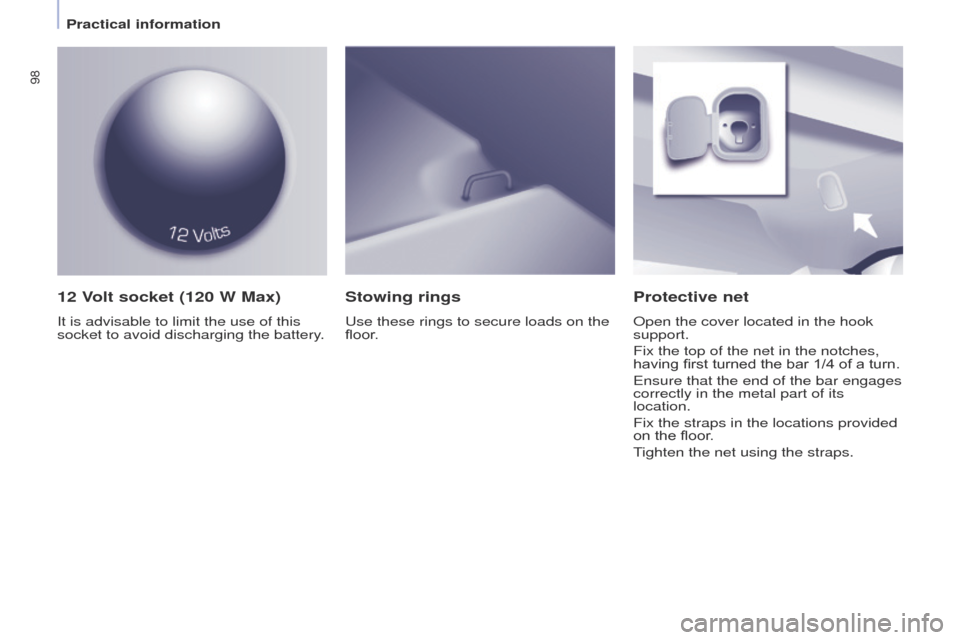
98
Partner_2_VP_en_Chap04_ergonomie_ed02-2014
12 Volt socket (120 W Max)
It is advisable to limit the use of this
socket to avoid discharging the battery.
Protective net
Open the cover located in the hook
support.
Fix the top of the net in the notches,
having first turned the bar 1/4 of a turn.
e
nsure that the end of the bar engages
correctly in the metal part of its
location.
Fix the straps in the locations provided
on the floor.
tighten the net using the straps.
Stowing rings
use these rings to secure loads on the
floor .
Practical information
Page 110 of 276
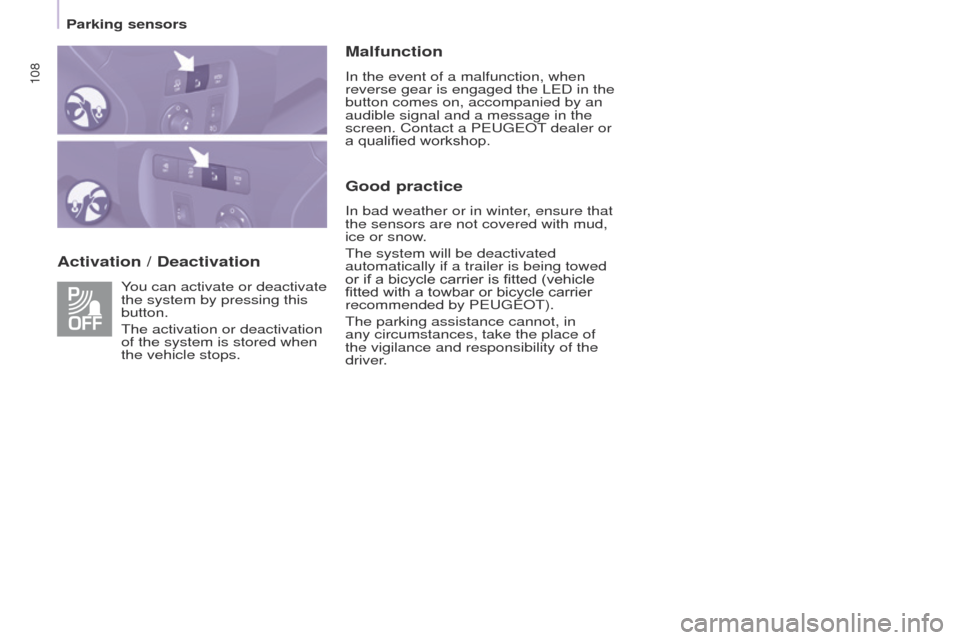
108
Partner_2_VP_en_Chap05_Securite_ed02-2014
Activation / DeactivationMalfunction
In the event of a malfunction, when
reverse gear is engaged the L
e D in the
button comes on, accompanied by an
audible signal and a message in the
screen. Contact a P
euge O t
dealer or
a qualified workshop.
Good practice
In bad weather or in winter, ensure that
the sensors are not covered with mud,
ice or snow.
t
he system will be deactivated
automatically if a trailer is being towed
or if a bicycle carrier is fitted (vehicle
fitted with a towbar or bicycle carrier
recommended by P
euge O t ).
t
he parking assistance cannot, in
any circumstances, take the place of
the vigilance and responsibility of the
driver.
You can activate or deactivate
the system by pressing this
button.
t
he activation or deactivation
of the system is stored when
the vehicle stops.
Parking sensors
Page 138 of 276
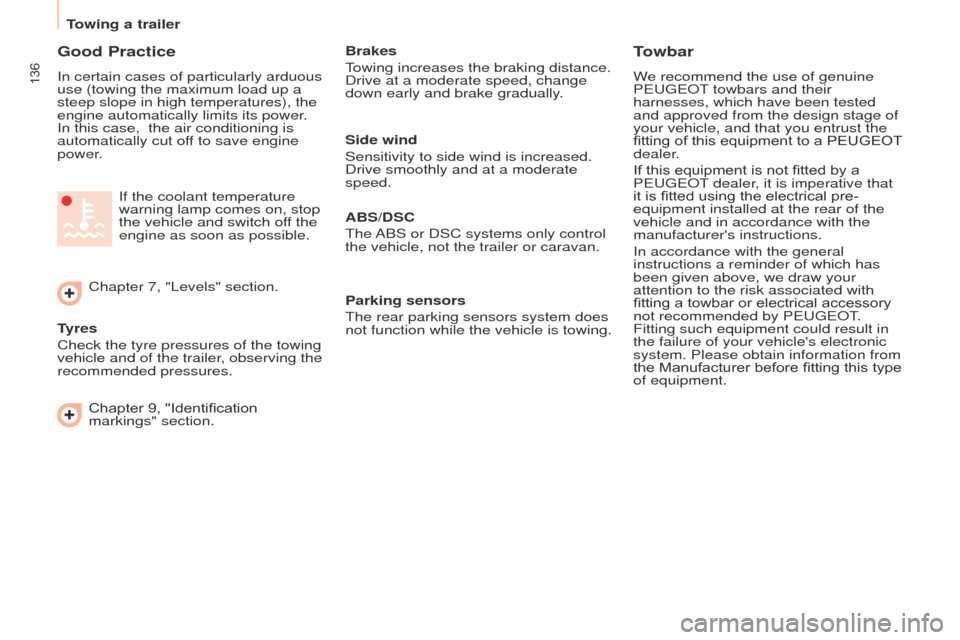
136
Partner_2_VP_en_Chap06_Accessoire_ed02-2014
Good Practice
In certain cases of particularly arduous
use (towing the maximum load up a
steep slope in high temperatures), the
engine automatically limits its power.
In this case, the air conditioning is
automatically cut off to save engine
power.
Tyres
Check the tyre pressures of the towing
vehicle and of the trailer, observing the
recommended pressures. Chapter 7, "Levels" section.If the coolant temperature
warning lamp comes on, stop
the vehicle and switch off the
engine as soon as possible. Brakestowing increases the braking distance.
Drive at a moderate speed, change
down early and brake gradually
.
Towbar
We recommend the use of genuine
Peuge O t towbars and their
harnesses, which have been tested
and approved from the design stage of
your vehicle, and that you entrust the
fitting of this equipment to a PEUGEOT
dealer.
If this equipment is not fitted by a
P
euge O t
dealer
, it is imperative that
it is fitted using the electrical pre-
equipment installed at the rear of the
vehicle and in accordance with the
manufacturer's instructions.
In accordance with the general
instructions a reminder of which has
been given above, we draw your
attention to the risk associated with
fitting a towbar or electrical accessory
not recommended by P
euge O t
.
Fitting such equipment could result in
the failure of your vehicle's electronic
system. Please obtain information from
the Manufacturer before fitting this type
of equipment.
Side wind
Sensitivity to side wind is increased.
Drive smoothly and at a moderate
speed.
ABS/DSC
t
he ABS or DSC systems only control
the vehicle, not the trailer or caravan.
Parking sensors
t
he rear parking sensors system does
not function while the vehicle is towing.
Chapter 9, "Identification
markings" section.
Towing a trailer
Page 162 of 276
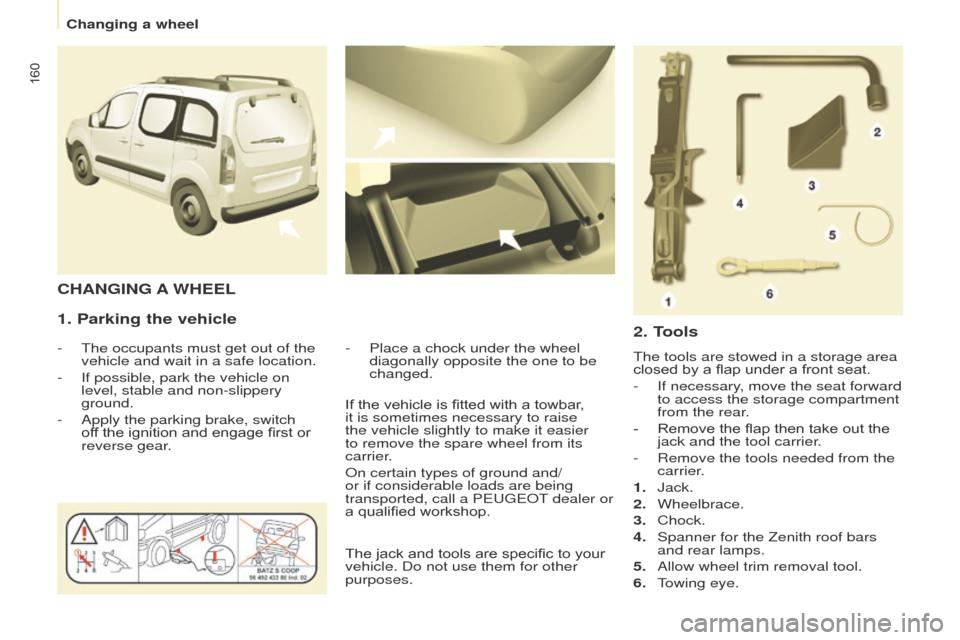
160
Partner_2_VP_en_Chap08_Aide-rapide_ed02-2014
1. Parking the vehicle
- the occupants must get out of the
vehicle and wait in a safe location.
-
If possible, park the vehicle on
level, stable and non-slippery
ground.
-
Apply the parking brake, switch
of
f the ignition and engage first or
reverse gear. -
Place a chock under the wheel
diagonally opposite the one to be
changed.
CHANGING A WHEEL
2. Tools
the tools are stowed in a storage area
closed by a flap under a front seat.
-
If necessary
, move the seat forward
to access the storage compartment
from the rear.
-
Remove the flap then take out the
jack and the tool carrier
.
-
Remove the tools needed from the
carrier
.
1.
Jack.
2.
Wheelbrace.
3.
Chock.
4.
Spanner for the Zenith roof bars
and rear lamps.
5.
Allow wheel trim removal tool.
6.
t
owing eye.
If the vehicle is fitted with a towbar
,
it is sometimes necessary to raise
the vehicle slightly to make it easier
to remove the spare wheel from its
carrier.
On certain types of ground and/
or if considerable loads are being
transported, call a P
euge
O
t
dealer or
a qualified workshop.
The jack and tools are specific to your
vehicle. Do not use them for other
purposes.
Changing a wheel
Page 180 of 276
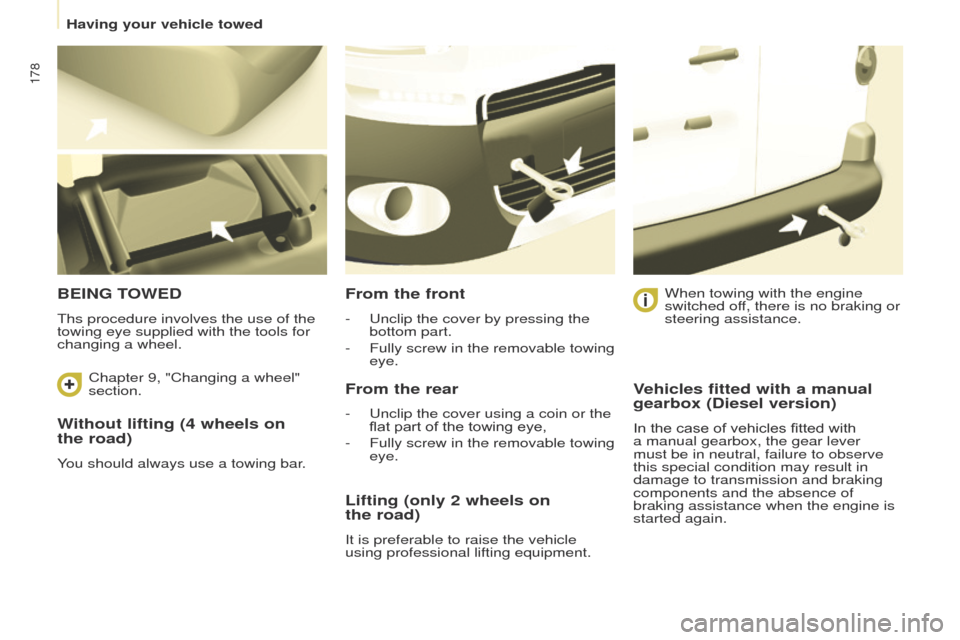
178
Partner_2_VP_en_Chap08_Aide-rapide_ed02-2014
Without lifting (4 wheels on
the road)
You should always use a towing bar.
BEING TOWED
ths procedure involves the use of the
towing eye supplied with the tools for
changing a wheel.
From the front
- unclip the cover by pressing the
bottom part.
-
Fully screw in the removable towing
eye.
From the rear
- unclip the cover using a coin or the
flat part of the towing eye,
-
Fully screw in the removable towing
eye. When towing with the engine
switched of
f, there is no braking or
steering assistance.
Lifting (only 2 wheels on
the road)
It is preferable to raise the vehicle
using professional lifting equipment.
Vehicles fitted with a manual
gearbox (Diesel version)
In the case of vehicles fitted with
a manual gearbox, the gear lever
must be in neutral, failure to observe
this special condition may result in
damage to transmission and braking
components and the absence of
braking assistance when the engine is
started again.
Chapter 9, "Changing a wheel"
section.
Having your vehicle towed